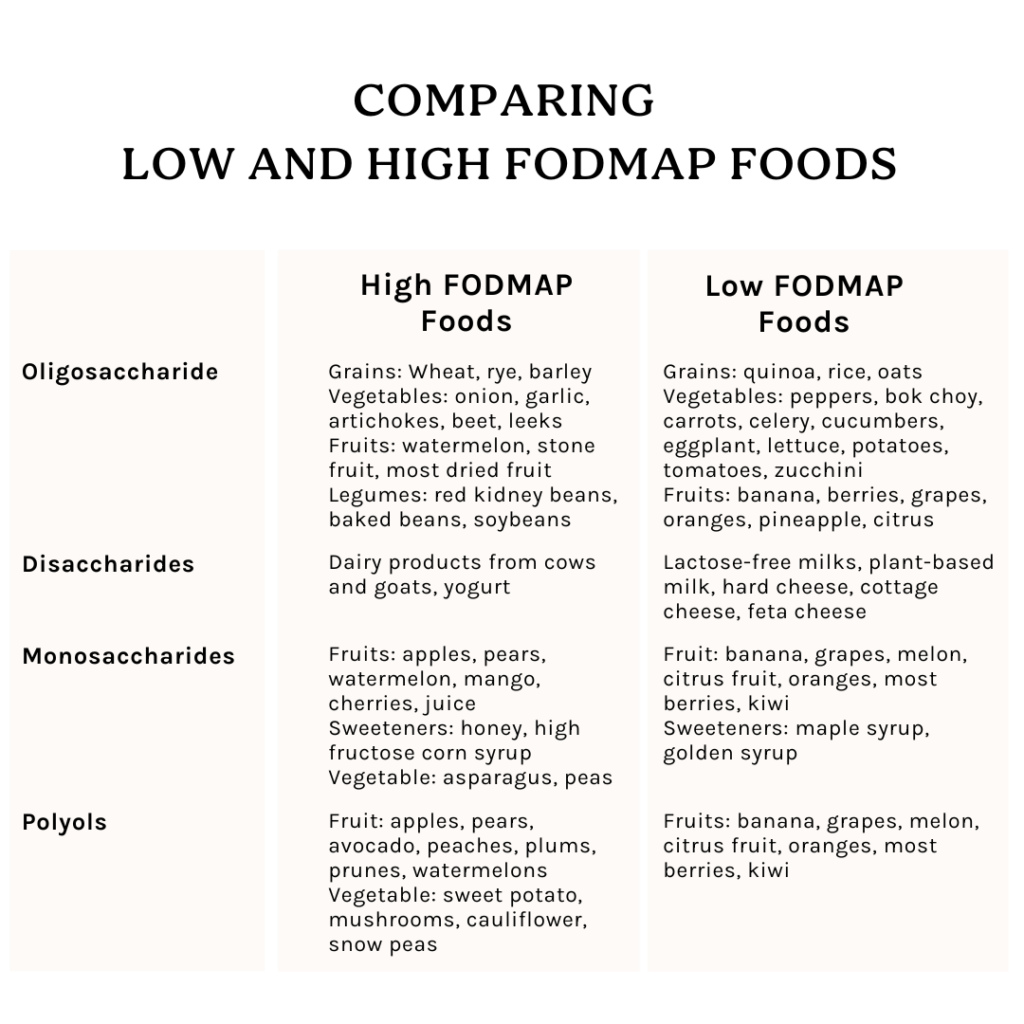FODMAP Diet – The Key to Better Gut Health

Gas, bloating, and stomach upset are common symptoms of menopause and older age. But what if your symptoms are telling you something more?
What Are FODMAPs?
Some groups of carbohydrates can be harder for some people to digest. FODMAP is a commonly used acronym for fermentable oligosaccharides, disaccharides, monosaccharides, and polyols. Let’s break down exactly what this means:
Fermentable: This is the process in which your gut bacteria breaks down undigested carbohydrates. The process releases gasses into our gut.
Oligosaccharides: This group is full of soluble plant fibers known as prebiotics. Prebiotics are beneficial as they feed the healthy bacteria in your gut. However, your body cannot digest them. Common foods in this group include onions, garlic, legumes, lentils, wheat, and rye.
Disaccharides: The naturally occurring sugar in lactose is the fermentable food here. This includes any dairy products like milk, yogurt, ice cream, and soft cheese.
Monosaccharides: All fruit contains some of this naturally occurring sugar. However, the amount varies based on the fruit. Fruits that are high in monosaccharides include apples, pears, and mangoes.
Polyols: Polyols are sugar alcohols that are commonly found in artificial sweeteners. They also occur naturally in some foods like cauliflower, peas, and stone fruits.
The problem with FODMAPs is that they are undigestable, meaning they aren’t broken down by our digestive enzymes. This forces our small intestine to pull in extra water to move the particles to our large intestine. The good bacteria living in our colon begin to break down the FODMAPs through fermentation. This process creates excess gas that may lead to pain or discomfort, bloating and changes in bowel movements.
Are FODMAPs Bad?
High FODMAP foods are not “bad.” In fact, many healthy foods are high FODMAPs. They also provide nutrients, like prebiotics, that benefit our gut bacteria. However, we know these foods are gas-producing. So if you have certain gastroenterological symptoms, like irritable bowel syndrome (IBS), it may be harder to tolerate these foods.
What is a FODMAP Diet?
When people are referring to a FODMAP diet, they generally mean an eating plan that is low in FODMAPs. A low FODMAP diet consists of a three-tiered plan:
- Phase 1 – The first phase is elimination. This is where you stop eating high FODMAP foods. This is not permanent and is generally recommended for about two to six weeks.
- Phase 2 – Next, you begin to slowly reintroduce high FODMAP foods from one group at a time. You will eat a small amount of a specific food for about three days. You increase the quantity you eat daily to see what your threshold for that food is. This helps to determine what foods you can tolerate and in what amount. This phase lasts between six and ten weeks.
- Phase 3 – Finally, you will personalize your diet based on what you found in phase two. You can reintroduce FODMAPs into your diet that you can tolerate. This will vary from person to person.
What Can I Eat on a Low FODMAP Diet?
The table below lists foods that are high in FODMAPs and low FODMAP alternatives. Remember, this list is not all-encompassing. Certain foods that affect one person may not affect someone else. When implementing a low FODMAP diet, be sure to work with your healthcare provider or registered dietitian to see what is best for you.

Who Benefits From a Low FODMAP Diet?
IBS affects about ten to twenty percent of the population, and this figure is predominantly women. People diagnosed with IBS may experience bloating, stomach pain, gas, diarrhea, and acid reflux. Patients often report that their symptoms are triggered by food.
If you have been diagnosed with IBS, a low FODMAP diet may help alleviate these symptoms. In fact, many countries consider a low FODMAP diet to be the primary treatment of the condition. One study found that up to eighty-six percent of patients with IBS found relief from their symptoms after implementing the low FODMAP diet plan.
FODMAP Diet Takeaway
A low FODMAP diet isn’t for everyone. In fact, it is not generally recommended for those who do not have IBS. The long-term health risks of the diet are not yet known. Following the diet too closely may result in nutrient deficiency and unfavorable changes to your gut health. If you are considering the FODMAP diet, consult your healthcare provider first.
Looking for more expert tips on healthy eating and managing menopause symptoms? Download Midday from the App Store or visit us at Midday.Health.
Erin Stanton, RDN, MPH, is a registered dietitian and certified lactation counselor residing in Atlanta, Georgia. She puts her master’s in public health degree to good use as a freelance writer focusing on various health and wellness topics, especially those pertaining to women and children.
Sign up for more unique women’s health content
By submitting this form, you agree to the Lisa Health Privacy Policy and Terms of Use


